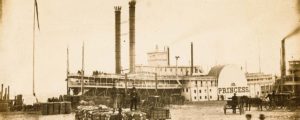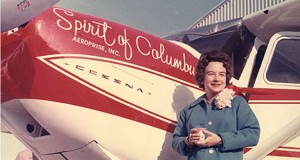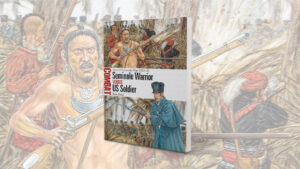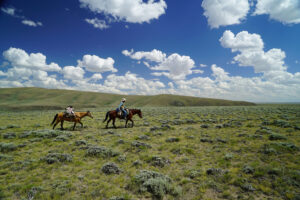Each fall the sun races the moon in northern New Mexico.
Jicarilla Apache runners competed in their annual Go-Jii-Ya harvest relay race some 200 years ago, and each September they continue to run this most important ceremony of the Jicarillas (Hee-kuh-REE-yuhs), the northernmost band of Apaches. The annual footrace pits the sun, represented by the Red Clan (Llaneros, or “Plains People”) with power over animals, against the moon, represented by the White Clan (Olleros, or “Water Jar People”) with power over plants and growing things. When the White Clan wins, the losing sun releases animals to the people, and the hunting is good. When the Red Clan wins, the losing moon allows for strong crops and the abundant harvest of wild foods— chokecherries, acorns and pinyon nuts. Before the advent of the Go-Jii-Ya, the Jicarillas believed nature would get out of balance, with too much of one kind of food. In the early days of the race, runners also won maidens as brides. Against all odds, the Red Clan has won the relay race for the past 15 years, which the Jicarillas believe has led to cooler, wetter weather—good for crops.
More about food than foot speed, the race—now held at Stone Lake on the Jicarilla Apache Reservation in northwest New Mexico—is both ceremony and harvest festival. It is a great insult to refuse food offered as one wanders from camp to camp. Tortillas roast on the grill together with chili, lamb ribs and legs of mutton. Sausages, stew and posole sizzle on an open oak fire.
In 1850 the Jicarillas, never a large tribe, numbered about 800. The Olleros lived on the banks of the Rio Grande from Abiquiu (northwest of Santa Fe) north to Alamosa, Colo. They hunted and planted crops and were friendly with Taos and Picuris pueblos, whose word for the Jicarillas meant “the protectors.” The Llaneros hunted buffalo on the Llano Estacado (“Staked Plains”) of northeastern New Mexico and were well known to travelers on the Santa Fe Trail. The Jicarillas’ great enemies were the Kiowa Apaches, whose language is almost identical to theirs, and the Comanches.
In the fall of 1849 Jicarillas abducted Ann White, the only white woman in the territory, her infant daughter, Virginia, and her black nursemaid. Celebrated frontiersman Kit Carson tried in vain to rescue the trio (see “Kit Carson’s Ride” in the April 2007 Wild West). At the March 1854 Battle of Cieneguilla (see story in the February 2008 Wild West) some 200- plus Jicarillas ambushed a 60-man patrol of the 1st Dragoon Regiment, killing almost half the men. By the late 1850s the starving Jicarillas had resorted to begging for food at agencies established by an 1855 treaty, selling their pottery and basketry or preying on travelers. Not until 1887 did the tribe get its own reservation.
Through it all the Jicarillas continued to hold the Go-Jii-Ya and also the Holiness Rite (suppressed by the Bureau of Indian Affairs in the 1920s and ’30s; now a private healing ceremony attended by family members) and the Adolescence Rite (a feast held soon after a girl reaches puberty, but also involving boys, with singing, dancing and work-related tasks).
No other Apache tribe has a ceremony similar to Go-Jii-Ya. The Pueblos—Taos, Picuris and San Juan—practice a harvest rite, but it is less important to them. Jicarillas take the ceremony seriously; men begin learning its secrets in childhood. For instance, walking across the racetrack is taboo and runners must prepare by staying away from women, meat and tobacco. No photography is allowed.
In pre-reservation days the races took place on the Rio Chama between Santa Cruz and Abiquiu. Jicarillas then and now gathered to camp, share food, dance, sing and prepare for the ceremony. Today they also hold an informal rodeo and powwow (competitive dance). At night soft drumbeats and singing rise over the camps, which vie with each other in rending war whoops.
There is much to do before the race. The Jicarillas must level and purify the track and build kivas (brush corrals) of aspen and cottonwood branches at each end of the track as private staging points for each clan. A tepee pole above each kiva flies the banner of the clan. Inside, sand paintings of sandhill cranes, eagles, hummingbirds and other swift birds adorn the floor. The day before the race the clan elders prepare, and when ready, they emerge singing—with their banner leading and drum beating—as they shuffle down the track toward one another’s kivas. They meet in the middle, approaching and backing off three times, their singing growing to a shout as they vie to outdo each other. Advancing to the end of the track, they soon reverse course and head for their home kiva. There, the drum beats at four intervals, summoning the runners.
Traditionally, tribesmen on horseback would follow the elders and the drum. Today, the participants travel by pickup truck, driving through camp (with much honking and whooping) to their practice tracks—White Clan by the lake, Red Clan over the hill to the north. The elders then choose the runners, putting the fastest in key positions. It is not important the teams are of equal size; the fastest will be mixed back in to the relay.
The participants return to camp while drivers park their pickups tailgate toward the track, lining its quarter-mile length. Early photos show Model-Ts and horse-drawn wagons lined up the same way. Still older photos show women on horseback, cheering for the runners. The pickups serve as box seats.
On race morning, elders prepare runners, painting their bodies red and white with ochre and clay in opposite patterns for the different clans. They fit the runners with headbands in the clan colors, a circlet of yucca leaves on the forehead, to which the wing feathers of fast birds are attached with a long ribbon in blue, red or white at the tip. Finally, they daub runners’ bodies with down. The two elders then jog to the track, waving eagle feathers to purify it. The runners finally emerge from the kivas and dance and sing down the track, each clan taking position by the other clan’s kiva and mounting its banner there. Half the runners return to the end near their clan’s kiva. Four referees armed with aspen fronds take positions along the track, and the race begins.
In the 2010 race the fastest runners raced neck and neck down the track, referees enforcing the rules, restraining spectators and encouraging their respective clan’s men with strokes of the aspen frond as they passed. Red Clan partisans told the White Clan runners to “slow down” and their own to run faster. As the White Clan fell behind, it sent in a fast runner for a second lap. That’s how it has always been done. The Red Clan led by a season (one lap) when a Red runner developed cramps and fell again and again—four times—as White gained ground. “I told them not to let him run!” one elder exclaimed. The race continued until Red was two seasons ahead and White admitted defeat—once again. It seemed like hours had passed. Some 60 to 100 men and boys had run, and the cheering never faltered. After the race came the turn of the small boys, painted and adorned like their elder brothers. They raced together in a group.
The clans formed up again, led by their respective banners and drums. They sang, danced and shuffled down the track toward each other. Approaching each other three times, they shuffled backward and repeated until the two clans were abreast. Then the opposing clansmen tossed presents high in the air for the other side to catch. Ears of corn, chili peppers, packaged candies and jerked meat all filled the air. The ritual continued until the members of each side and the spectators had filled their hands and arms with groceries.
Originally published in the October 2011 issue of Wild West. To subscribe, click here.




